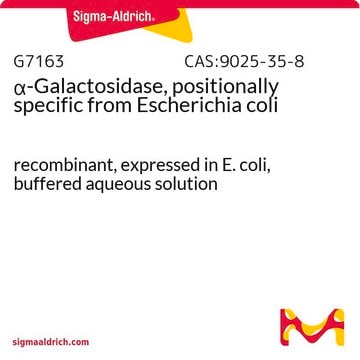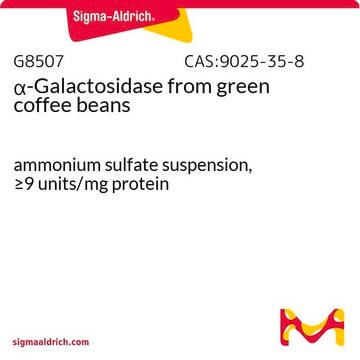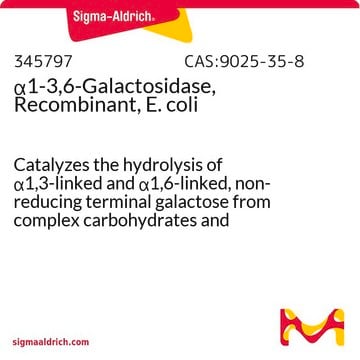G7673
α-Galactosidase I, Alkaline from Cucumis melo
Synonym(s):
α-D-Galactoside Galactohydrolase, Melibiase
Sign Into View Organizational & Contract Pricing
All Photos(1)
About This Item
CAS Number:
MDL number:
UNSPSC Code:
12352204
NACRES:
NA.54
Recommended Products
recombinant
expressed in E. coli
Assay
≥85% (SDS-PAGE)
form
lyophilized solid
specific activity
≥20 units/mg protein
mol wt
apparent mol wt ~84 kDa by SDS-PAGE
shipped in
wet ice
storage temp.
−20°C
General description
Alkaline α-Galactosidase I is a glycoside hydrolase, separated from the extracts of melon fruits. The activity of this enzyme is found to increase during the early stages of ovary development and fruit set.
Application
Alkaline α-Galactosidase I was used to assay enzyme activity with 2 mmp-nitrophenyl-α-d-galactoside as substrate at pH 6.5 to compare with the enzyme activity of α-Gal A isolated and purified from Sf-9 insect cells infected with a recombinant baculovirus encoding normal α-Gal A gene.
Biochem/physiol Actions
α-Galactosidase form I from melon may play a significant role in photoassimilate partitioning in sink tissue. The form I enzyme has a preferred activity with raffinose and significant activity with stachyose. A unique feature of this enzyme is that it exhibits weak product inhibition by galactose.
This enzyme shows a preference for raffinose and also activity with stachyose. Unlike other a-Galctosidases, this enyzme also shows weak inhibition by galactose.
Physical properties
This enzyme exhibits maximal activity between 30-37°C. Activity declines above 40°C.
Unit Definition
One unit will hydrolyze 1.0 μmole of p-nitrophenyl α-D-galactoside to p-nitrophenol and D-galactose per minute at pH 7.8 at 30 °C.
Physical form
The product is supplied as a lyophilized powder containing Tris-HCl buffer salts, DTT, EDTA, and NaCl.
Signal Word
Warning
Hazard Statements
Precautionary Statements
Hazard Classifications
Eye Irrit. 2 - Skin Irrit. 2 - STOT SE 3
Target Organs
Respiratory system
Storage Class Code
11 - Combustible Solids
WGK
WGK 3
Flash Point(F)
Not applicable
Flash Point(C)
Not applicable
Certificates of Analysis (COA)
Search for Certificates of Analysis (COA) by entering the products Lot/Batch Number. Lot and Batch Numbers can be found on a product’s label following the words ‘Lot’ or ‘Batch’.
Already Own This Product?
Find documentation for the products that you have recently purchased in the Document Library.
N Asano et al.
European journal of biochemistry, 267(13), 4179-4186 (2000-06-24)
Fabry disease is a lysosomal storage disorder caused by deficient lysosomal alpha-galactosidase A (alpha-Gal A) activity. Deficiency of the enzyme activity results in progressive deposition of neutral glycosphingolipids with terminal alpha-galactosyl residue in vascular endothelial cells. We recently proposed a
Gao et al.
Plant physiology, 119(3), 979-988 (1999-03-09)
The cucurbits translocate the galactosyl-sucrose oligosaccharides raffinose and stachyose, therefore, alpha-galactosidase (alpha-D-galactoside galactohydrolase, EC 3.2.1.22) is expected to function as the initial enzyme of photoassimilate catabolism. However, the previously described alkaline alpha-galactosidase is specific for the tetrasaccharide stachyose, leaving raffinose
Nir Carmi et al.
The Plant journal : for cell and molecular biology, 33(1), 97-106 (2003-08-29)
Raffinose and stachyose are ubiquitous galactosyl-sucrose oligosaccharides in the plant kingdom which play major roles, second only to sucrose, in photoassimilate translocation and seed carbohydrate storage. These sugars are initially metabolised by alpha-galactosidases (alpha-gal). We report the cloning and functional
Multicomponent nanoparticles as nonviral vectors for the treatment of Fabry disease by gene therapy.
Aritz Pérez Ruiz de Garibay et al.
Drug design, development and therapy, 6, 303-310 (2012-11-03)
Gene-mediated enzyme replacement is a reasonable and highly promising approach for the treatment of Fabry disease (FD). The objective of the present study was to demonstrate the potential applications of solid lipid nanoparticle (SLN)-based nonviral vectors for the treatment of
Antonio Pisani et al.
Molecular genetics and metabolism, 107(3), 267-275 (2012-09-12)
Anderson-Fabry disease is an X-linked lysosomal storage disorder resulting from the deficiency of the hydrolytic enzyme alpha galactosidase A, with consequent accumulation of globotrioasoyl ceramide in cells and tissues of the body, resulting in a multi-system pathology including end organ
Our team of scientists has experience in all areas of research including Life Science, Material Science, Chemical Synthesis, Chromatography, Analytical and many others.
Contact Technical Service








